基于主动式阻尼的混合式步进电机转速振荡抑制控制
施 雨 武志涛 苏晓英 佟文明
基于主动式阻尼的混合式步进电机转速振荡抑制控制
施 雨1武志涛1苏晓英1佟文明2
(1. 辽宁科技大学电子与信息工程学院 鞍山 114051 2. 沈阳工业大学特种电机与高压电器教育部重点实验室 沈阳 110870)
混合式步进电机因其特殊的机械结构导致自身阻尼极小,在实际运行过程中会发生振荡过大,甚至失步的问题。为提高混合式步进电机的控制品质,提出一种基于主动式阻尼的步进电机转速振荡抑制方法。首先,将电机模型转化至同步旋转dq坐标系,将电流d控制恒为额定电流,利用位置误差和速度误差调节电流q生成瞬时转矩,抑制电机运行时存在的振荡现象。其次,为实现电机闭环反馈控制,提出一种将同步频率提取滤波器(SFF)与三阶锁相环(PLL3rd)相结合的无传感器控制方法。SFF可以滤除反电动势信号中的高次谐波,PLL3rd能消除转速变化过程中的稳态误差。实验证明,该方法有效抑制了步进电机运行过程中的振荡现象,提升了电机的运行品质。
混合式步进电机 双闭环控制 主动式阻尼控制 锁相环 同步频率提取滤波器
0 引言
步进电机广泛应用于医疗、办公和工业自动化等领域。在各种类型的步进电机中,混合式步进电机(Hybrid Stepper Motor, HSM)因其拥有更高的工作效率和输出转矩,应用最为普遍[1-2]。混合式步进电机一般采用开环运行,但因其特殊的机械结构,导致电机的黏滞阻尼系数很小,在实际运行过程中易产生抖振、失步等问题,严重限制了混合式步进电机的应用场景。
为了解决上述问题,必须以外加或控制的方式增加电机的阻尼。外加阻尼的方法分为机械式和电子式,例如,文献[3]在电机轴与端盖之间放置一个阻尼胶圈,利用胶圈与转轴间的摩擦来增加阻尼。但是,机械阻尼存在安装空间,以及阻尼使用过久令造成阻尼参数改变的问题。电子式阻尼通常利用无源元件如电阻或电容改善步进电机的阻尼系数过小的问题,但此方法会减小电机的输出转矩。利用微步进(micro-stepping)控制[4]亦可有效减少由于阻尼过小所造成的振荡,但此方法仅降低振荡的幅度,并未改变其阻尼。除上述的方法之外,以闭回路的控制方式改变电机阻尼参数,也可以大幅提高步进电机的性能[5]。文献[6]在电机闭环控制过程中,根据实际值与估测值间的误差调节生成补偿电流以解决电机振荡问题,但此方法计算需基于电机参数且通过光学编码器实现闭环控制。文献[7]提出了一种基于人工神经网络的阻尼控制器,用以改善电机共振现象,但此控制器只适用于电机低速运行,且相关电机转子信息通过编码器进行反馈。外加编码器会导致系统成本增加,并且当温度变化或是处于恶劣环境时,编码器会降低电机控制系统的可靠性,而无传感器控制方式则可以避免出现上述问题。
电机无传感器控制方法一般可以分为两类,分别为低速状态下的高频信号注入法和中高速状态下的反电动势观测法。文献[8]采用脉振高频信号注入法,对估计的dq轴注入直流信号,通过功率计算跟踪最大转矩电流比工作点,提高电机的转矩输出。高频信号注入法虽然不受电机参数变化的影响,但缺点是需外加信号且信号处理过程较复杂,电机动稳态特性不理想同时会影响控制系统带宽。目前,主流方法为反电动势观测法,即通过对反电动势观测并处理获取电机转子信息。目前,主要的反电动势观测法包括模型参考自适应法、滑模观测器法、状态观测器法等。文献[9]提出基于滑模观测器的无传感器速度控制,并通过李雅普诺夫函数分析确定观测器的增益。滑模观测器法不依赖于精确的电机数学模型,且对外部扰动具有较强鲁棒性,一定程度上解决了系统参数变化及扰动带来的影响。但传统滑模观测器容易导致系统发生抖振现象[10],并且外加低通滤波器会引起相位滞后,降低了滑模观测器的观测精度。文献[11]提出了一种基于李雅普诺夫稳定理论的自适应神经网络无速度传感器控制方法,但此方法存在设计参数多及计算量大等问题。此外,该方法在高速域的观测精度也有待提高。文献[12]针对步进电机中高速运行阶段,通过龙伯格观测器获得反电动势信息,利用锁相环对反电动势进行处理得到转子位置。传统锁相环虽然可以避免微分运算引起的噪声影响,但当电机转速发生变化时其动态性能较差。

1 混合式步进电机数学模型
在固定坐标系中,两相混合式步进电机的数学模型[13]表示为

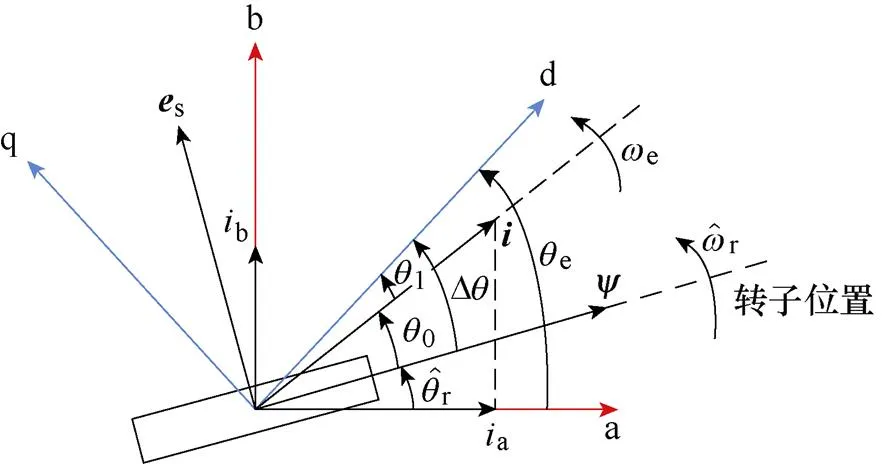
图1 坐标轴关系矢量图
转换至同步dq坐标系的电机数学模型表示为

同步dq坐标系下的电机输出转矩方程为

步进电机的机械运动方程[14]为
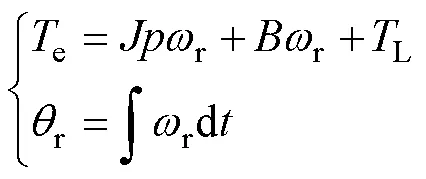
2 步进电机主动式阻尼双闭环控制

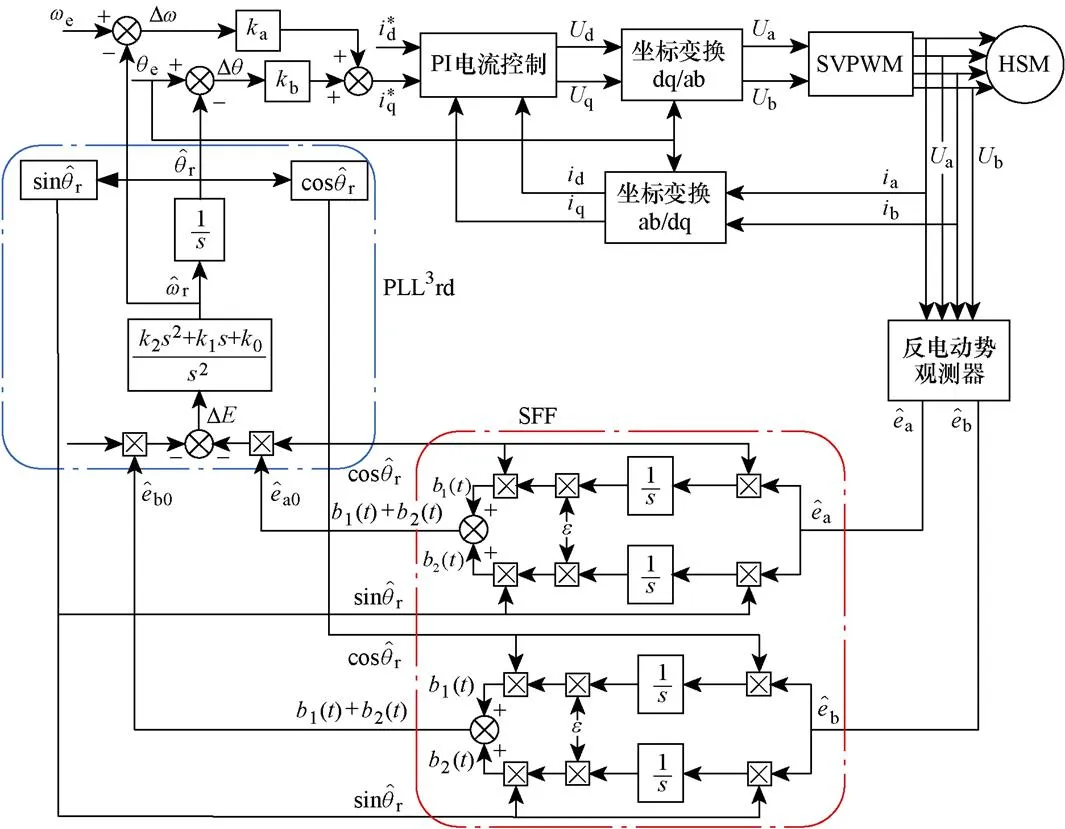
图2 混合式步进电机主动式阻尼双闭环控制框图
由图2可得
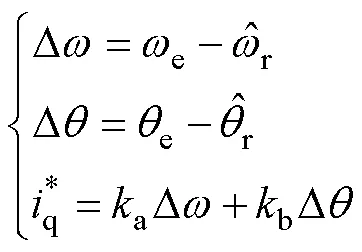

由于
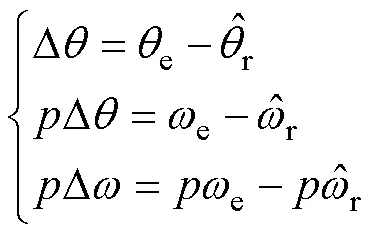
式(6)求导后,将式(7)代入可推出


标准二阶系统传递函数表示为

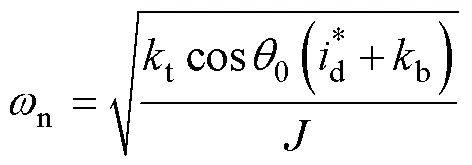

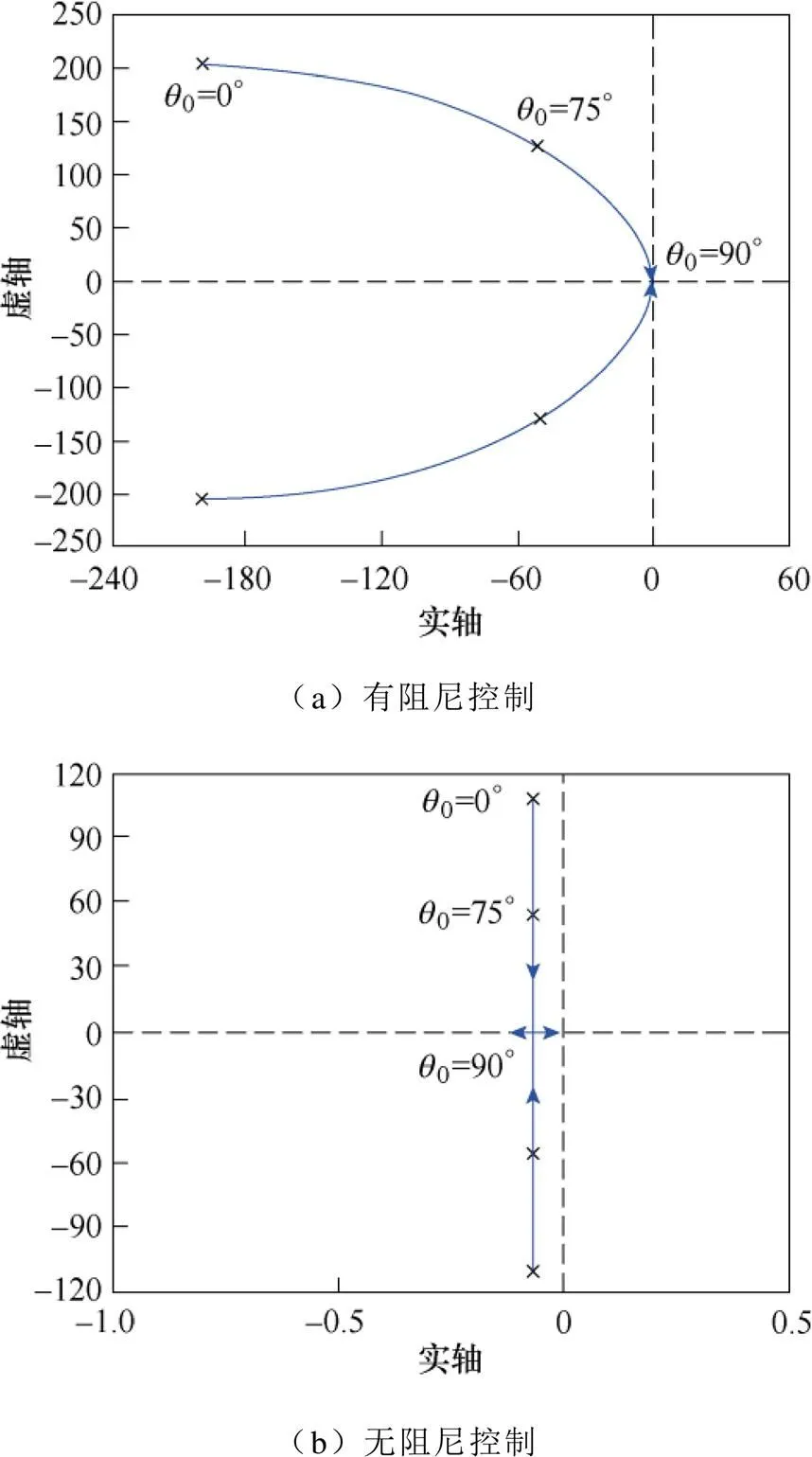
图3 变化时系统根轨迹图
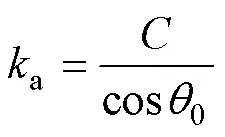
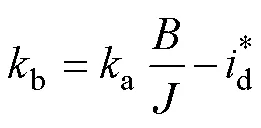
将式(13)、式(14)代入式(9)中,可得

3 SFF-PLL3rd速度观测器
3.1 基于三阶锁相环(PLL3rd)的速度观测器
获取电机转子位置和速度信息是实现电机主动式阻尼双闭环控制的重要环节,本文设计了一种基于三阶锁相环(PLL3rd)的速度观测器。

由式(16)可得反电动势中包含了电机转子信息,通过反正切运算后即可获得转子位置。
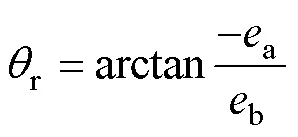
再对转子位置信息进行微分就可以得到转子速度,但微分运算将放大高频噪声,会降低速度观测器的观测精度。反电动势信号输出后利用锁相环对其进行处理,能避免微分运算引起的噪声影响[16]。






图4 三阶锁相环结构框图
由图4可知

其中
当角度跟踪误差较小时可得

根据图4和式(23)可得PLL3rd闭环传递函数表示为




将式(27)和式(21)对比分析可得,PLL3rd可以有效消除电机的稳态误差,在加减速状态下将稳态误差降为零。
3.2 同步频率提取滤波器(SFF)
由式(16)得到的反电动势信号中常含有大量谐波分量[18],表示为

锁相环虽然可以对反电动势信号进行处理得到转子信息,但无法抑制谐波分量对观测器精度的影响,为了提高速度观察器的观测精度,本文先利用同步频率提取滤波器(SFF)对反电动势的基波分量进行提取,再将处理后的信号送入PLL3rd获取转子信息,SFF结构框图如图5所示。
通过式(28)和图5的结构框图,可得

图5 同步频率提取滤波器结构框图

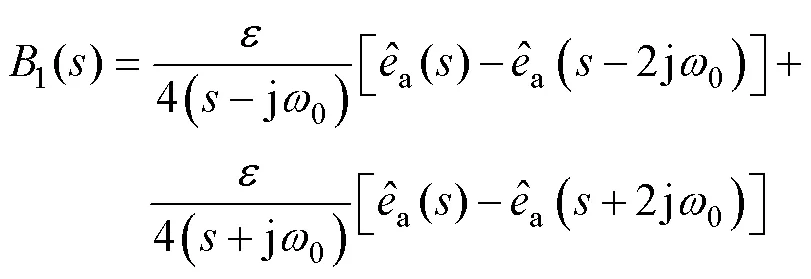

因此,同步频率提取滤波器的传递函数表示为

由式(32)可得其幅频特性为
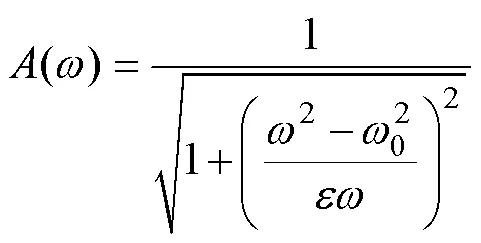
4 实验与分析
为验证本文提出的主动式阻尼双闭环控制方法的有效性,本实验所用混合式步进电机的参数见表1。基于STM32F407开发板的电机控制实验装置如图6所示,带负载转矩为额定值1.2 N×m,同时采用N38-06-N型600线增量型旋转编码器(未参与控制,仅用于对比观测值)测量电机真实速度,以对比验证速度观测器的有效性。
表1 混合式步进电机参数

Tab.1 Parameters of HSM

图6 实验系统实物
4.1 HSM反电动势信号分析实验
分别采用传统PLL及SFF-PLL3rd观测器运行,反电动势信号及傅里叶分析实验结果如图7、图8所示。
图7为在额定负载下,转速恒为100 Hz时采用传统PLL方法获得的实验结果。图7a中反电动势信号发生明显畸变,信号中含有谐波分量。利用傅里叶变换(Fast Fourier Transform, FFT)分析反电动势信号中的谐波成分,其中谐波分量的主要成分为3、5、7次谐波,如图7b所示。
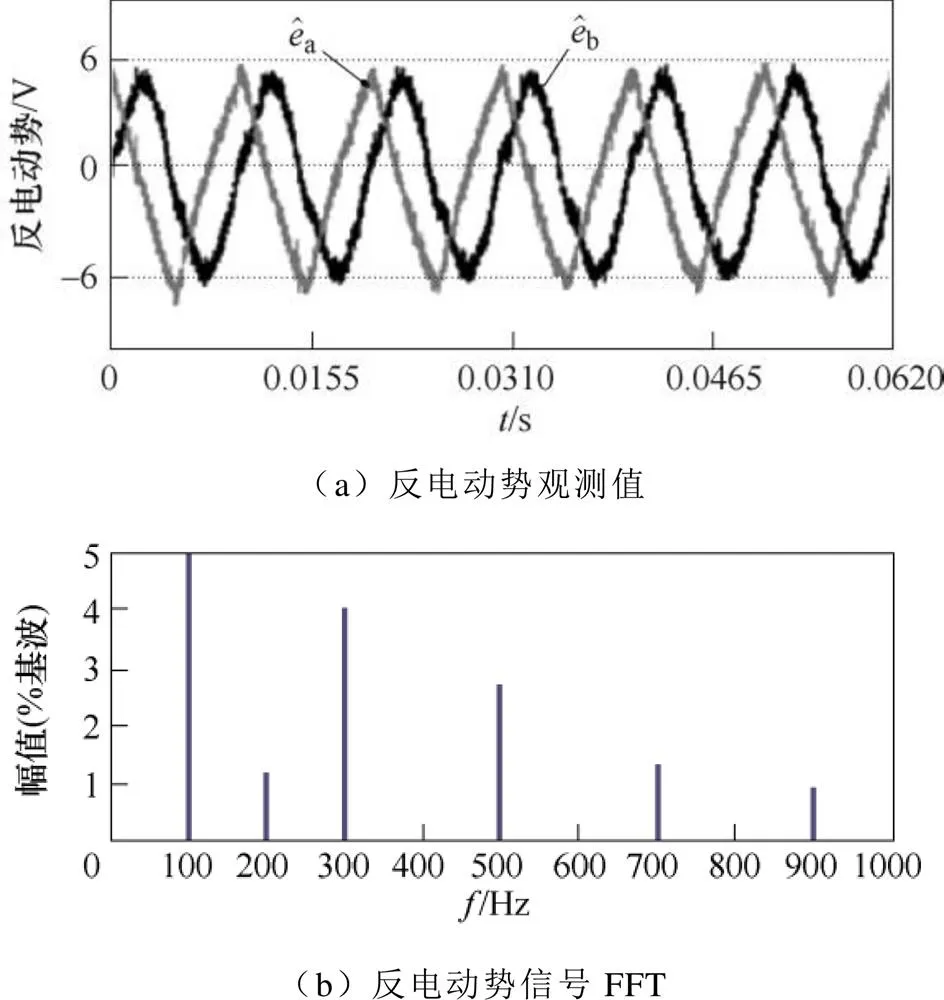
图7 传统锁相环观测器的实验结果
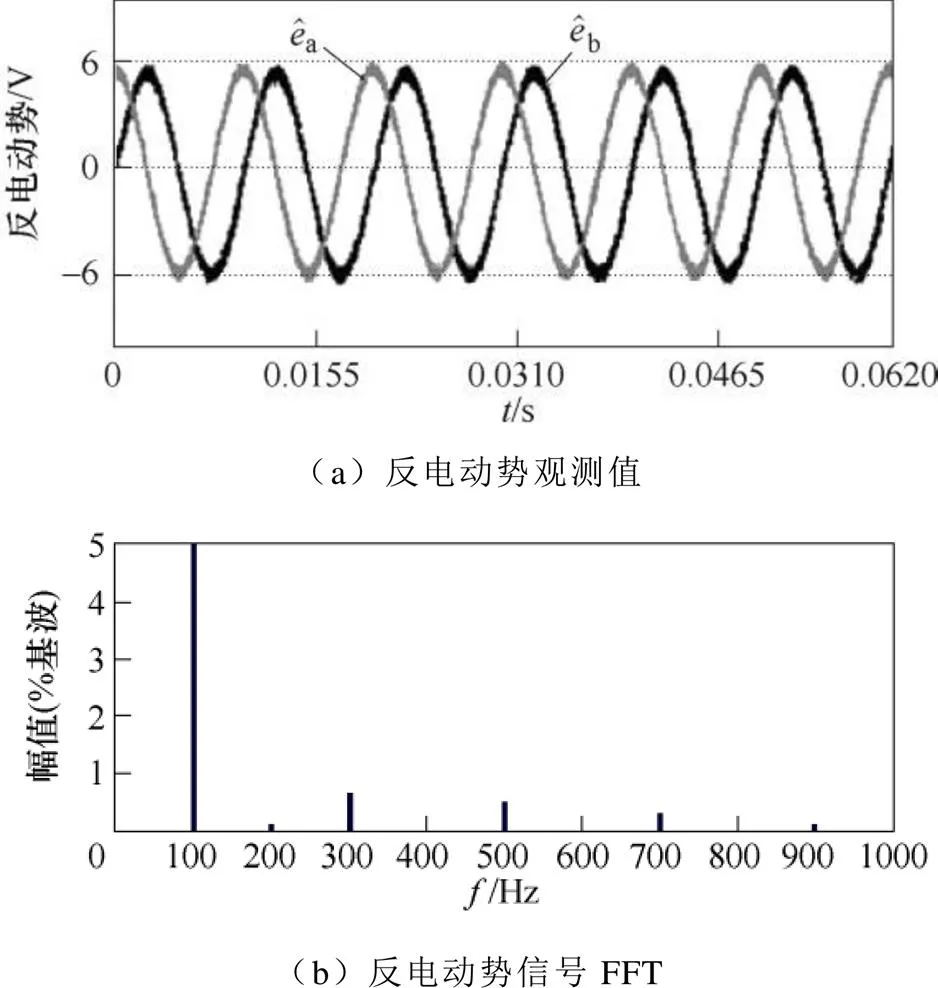
图8 SFF-PLL3rd观测器的实验结果
图8为转速恒为100 Hz时,电机在额定负载下通过SFF-PLL3rd方法获得的实验结果。图8a与图7a对比可得,反电动势波形更加平滑。图8b与图7b对比可知,2、3、5、7次谐波分量幅值明显减小,证明SFF能有效滤除其他频率的干扰。由上述实验可得,本文提出的SFF-PLL3rd的信号处理方法有效滤除反电动势中的谐波分量,提高信息观测精度。
4.2 混合式步进电机转速振荡抑制实验
本文提出的阻尼控制的设计原则是在电机低速运行时,阻尼控制可以对转速振荡现象起到一定抑制效果(可用性原则),而在中高速时,阻尼控制能有效抑制转速振荡(有效性原则)。因此,在不同转速下,验证基于主动式阻尼的双闭环控制方法对混合式步进电机转速振荡的抑制效果。


图9 无阻尼控制时转速响应及误差波形(we=10 Hz)
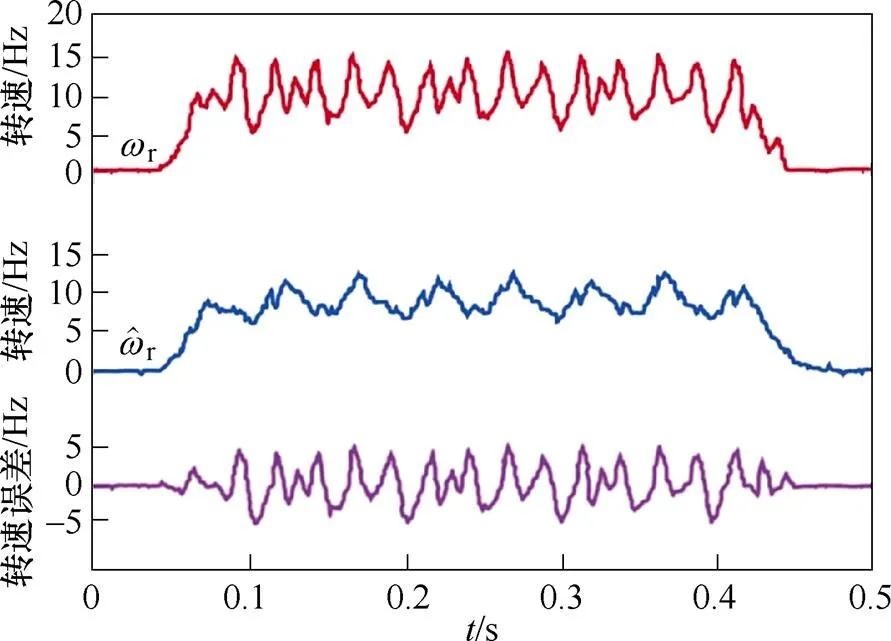
图10 有阻尼控制时转速响应及误差波形(we=10 Hz)

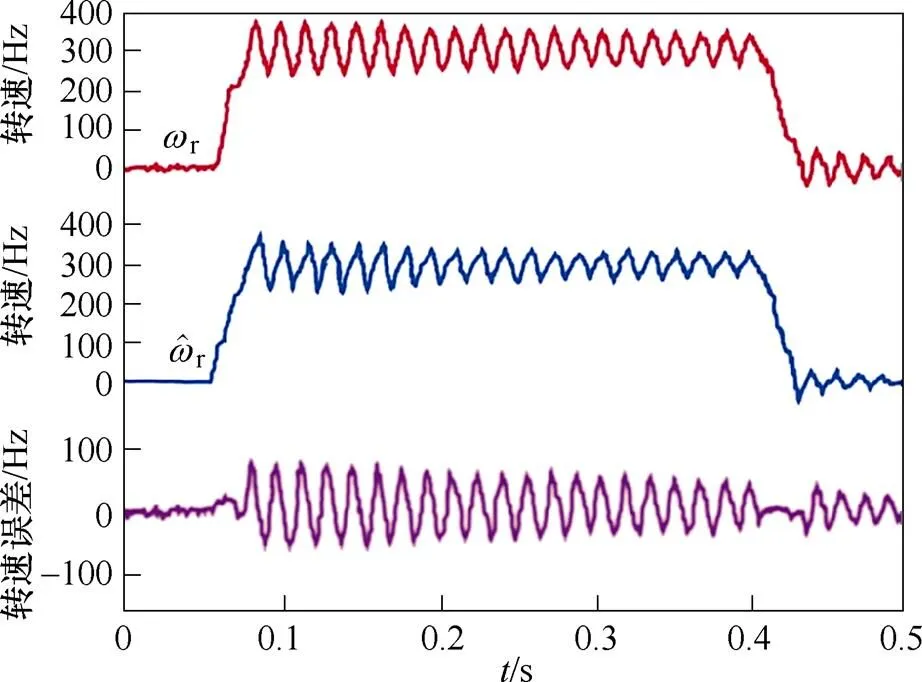
图11 无阻尼控制时转速响应及误差波形(we=300 Hz)
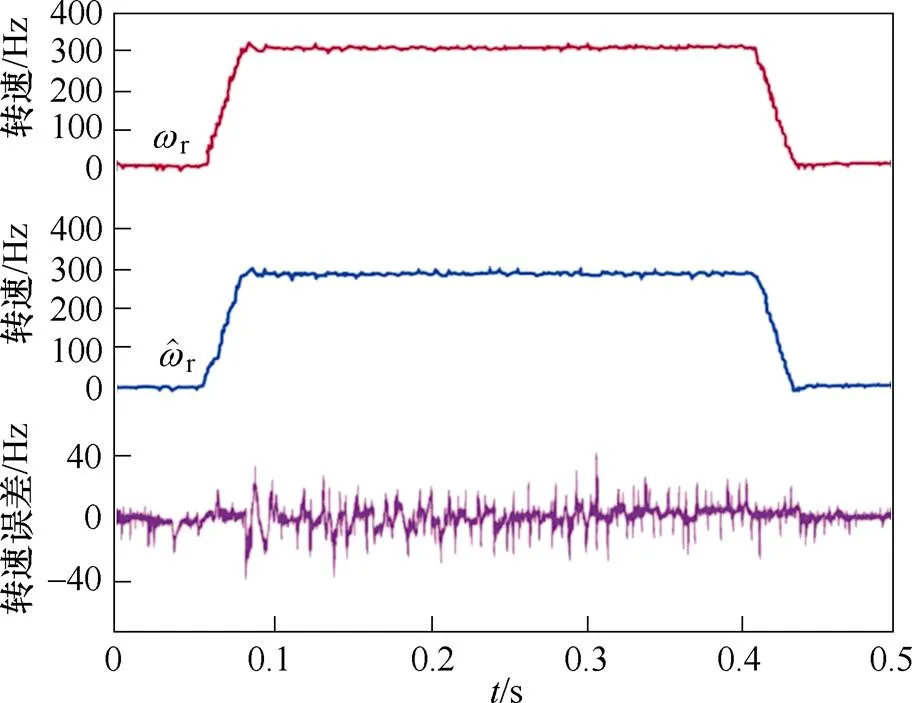
图12 有阻尼控制时转速响应及误差波形(we=300 Hz)


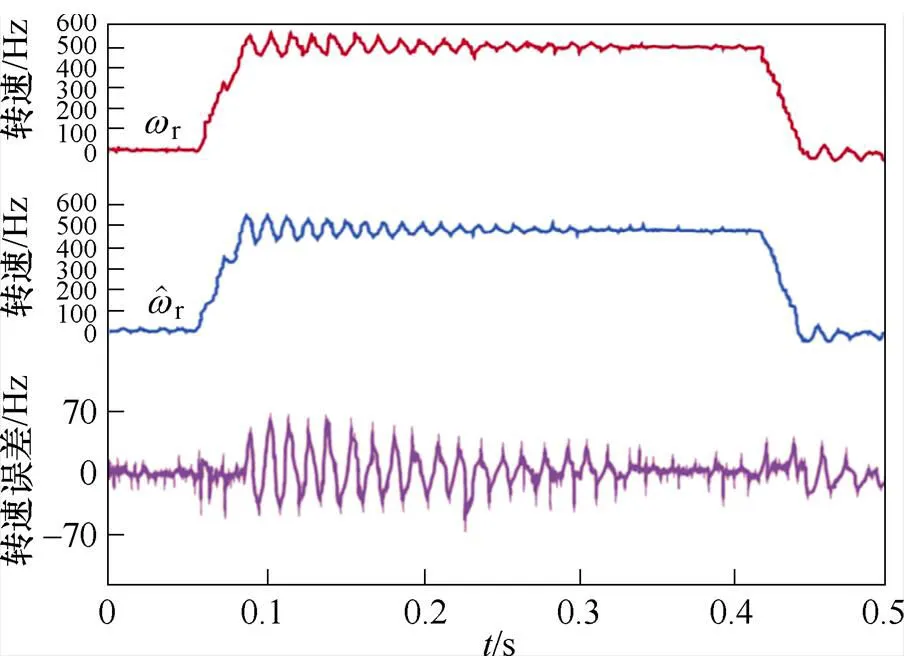
图13 无阻尼控制时转速响应及误差波形(we=500 Hz)
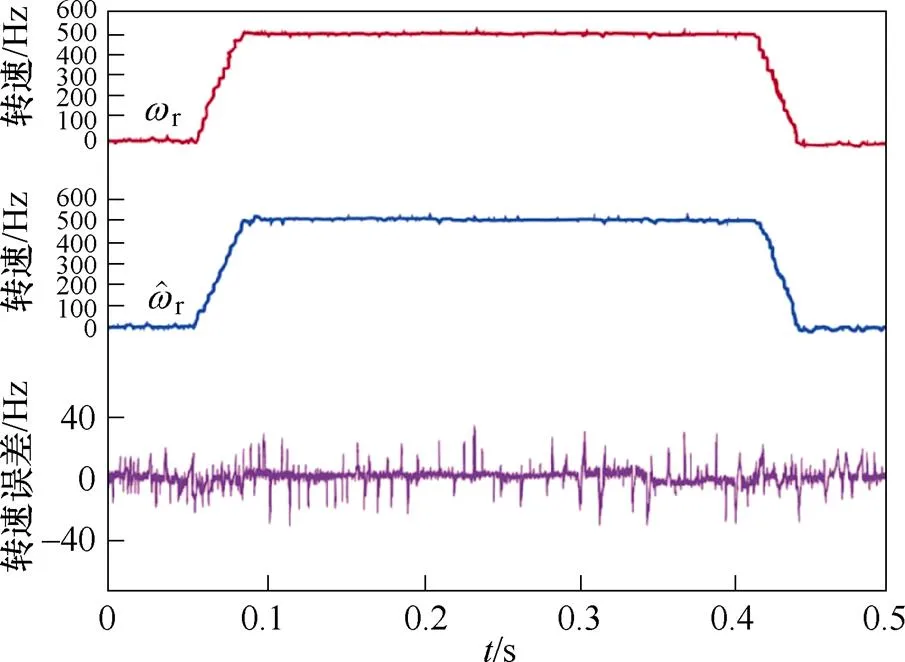
图14 有阻尼控制时转速响应及误差波形(we=500 Hz)
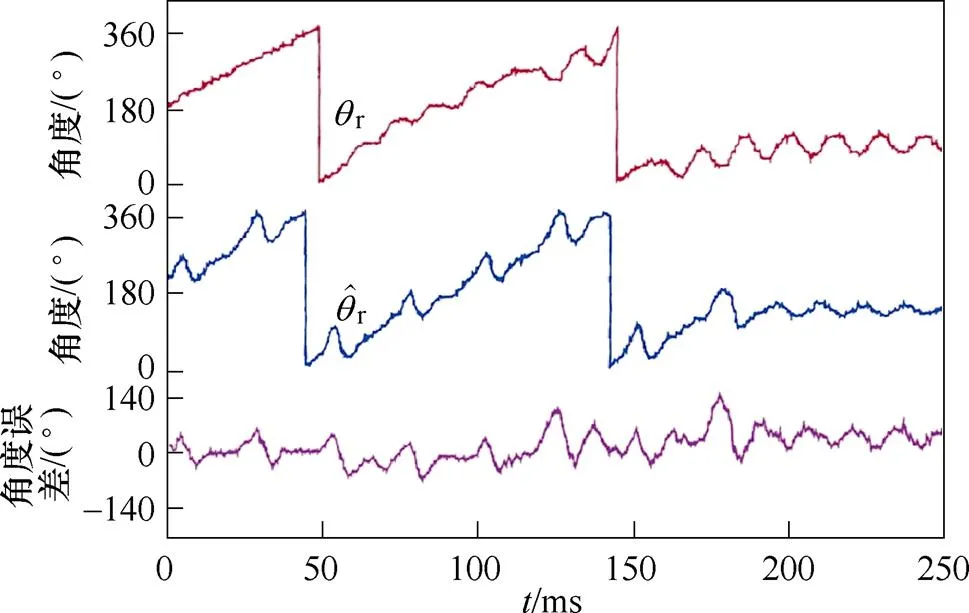
图15 无阻尼控制时的位置响应(we=10 Hz)
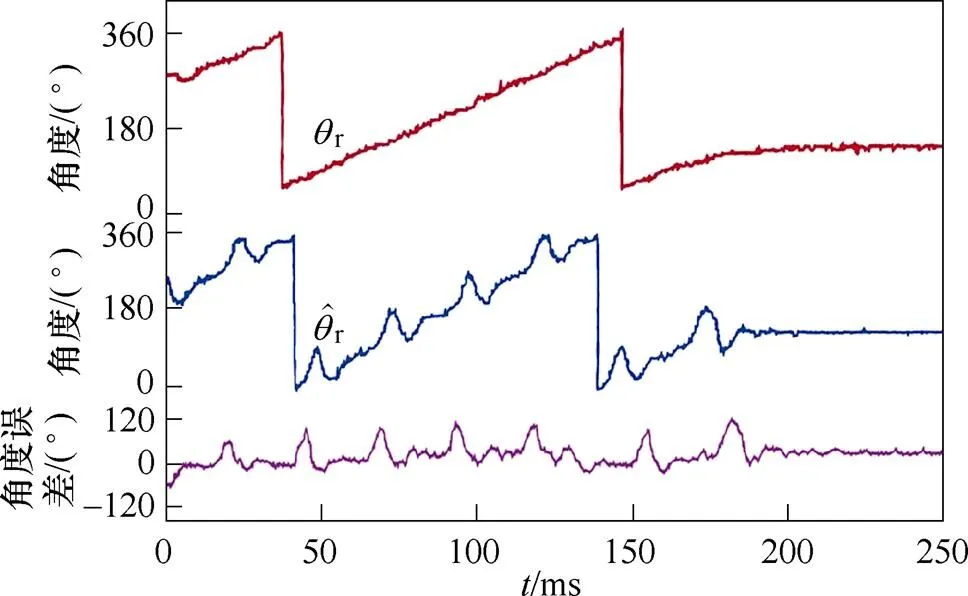
图16 有阻尼控制时的位置响应(we=10 Hz)


图17 无阻尼控制时的位置响应(we=300 Hz)

图18 有阻尼控制时的位置响应(we=300 Hz)

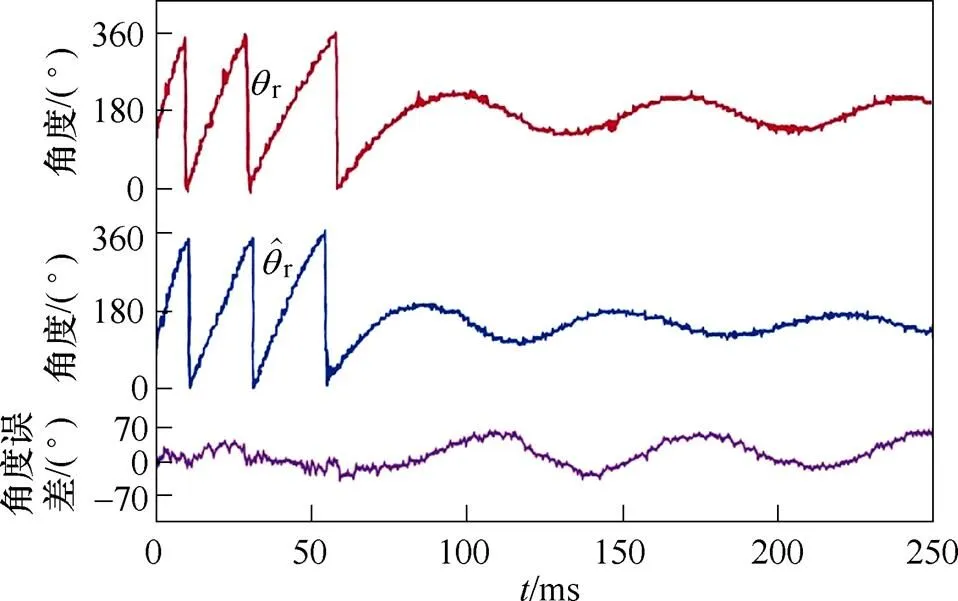
图19 无阻尼控制时的位置响应(we=500 Hz)
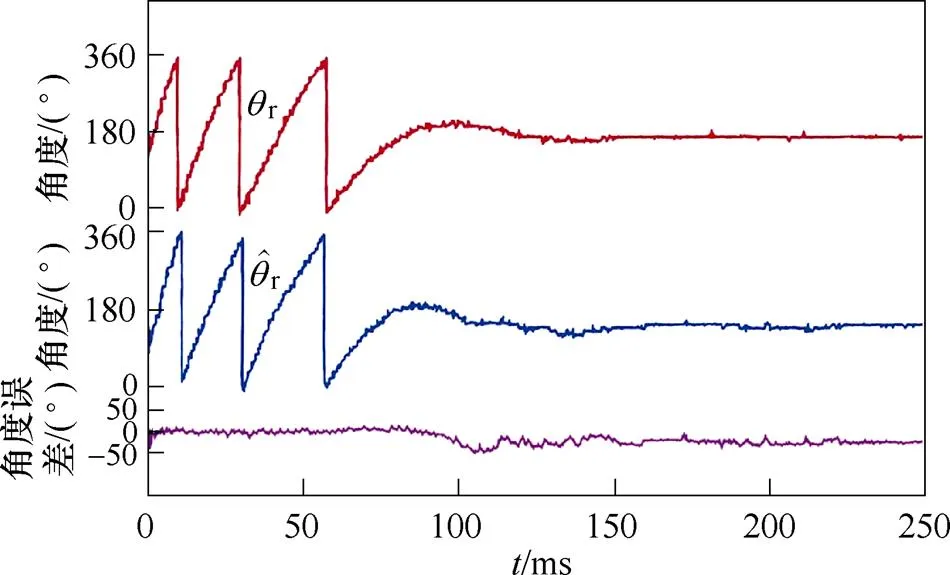
图20 有阻尼控制时的位置响应(we=500 Hz)
5 结论

[1] Normanyo E, Agyare O R, Rashid R A. Matlab implementation of position control of a hybrid stepper motor using fuzzy logic controller[C]//2019 IEEE AFRICON, Accra, Ghana, 2020: 1-8.
[2] Kim S K, Ahn C K. Variable-performance positioning law for hybrid-type stepper motors via active damping injection and disturbance observer[J]. IEEE Transa- ctions on Circuits and Systems II: Express Briefs, 2021, 68(4): 1308-1312.
[3] Kenjō T. Stepping motors and their microprocessor controls[M]. Oxford: Clarendon Press, 1984.
[4] 陈学军. 步进电机细分驱动控制系统的研究与实现[J]. 电机与控制应用, 2006, 33(6): 48-50.
Chen Xuejun. Research and realization of subdivided driving system of stepping motor[J]. Electric Machines & Control Application, 2006, 33(6): 48-50.
[5] Sun Hongbo, Jiang Dong, Yang Jichang. Synchronous vibration suppression of magnetic bearing systems without angular sensors[J]. CES Transactions on Electrical Machines and Systems, 2021, 5(1): 70-77.
[6] Le K M, Van Hoang H, Jeon J W. An advanced closed-loop control to improve the performance of hybrid stepper motors[J]. IEEE Transactions on Power Electronics, 2017, 32(9): 7244-7255.
[7] Le Q N, Jeon J W. Neural-network-based low-speed- damping controller for stepper motor with an FPGA[J]. IEEE Transactions on Industrial Electronics, 2010, 57(9): 3167-3180.
[8] 赵文祥, 刘桓, 陶涛, 等. 基于虚拟信号和高频脉振信号注入的无位置传感器内置式永磁同步电机MTPA控制[J]. 电工技术学报, 2021, 36(24): 5092- 5100.
Zhao Wengxiang, Liu Huan, Tao Tao, et al. MTPA control of sensorless IPMSM based on virtual signal and high-frequency pulsating signal injection[J]. Transactions of China Electrotechnical Society, 2021, 36(24): 5092-5100.
[9] Saadaoui O, Khlaief A, Abassi M, et al. A sliding- mode observer for high-performance sensorless control of PMSM with initial rotor position dete- ction[J]. International Journal of Control, 2017, 90(2): 377-392.
[10] 梅三冠, 卢闻州, 樊启高, 等. 基于滑模观测器误差补偿的永磁同步电机无位置传感器控制策略[J]. 电工技术学报, 2023, 38(2): 398-408.
Mei Sanguan, Lu Wenzhou, Fan Qigao, et al. Sensorless control strategy of permanent magnet synchronous motor based on error compensation estimated by sliding mode observer[J]. Transactions of China Electrotechnical Society, 2023, 38(2): 398- 408.
[11] Zhang Guoqiang, Wang Gaolin, Xu Dianguo, et al. ADALINE-network-based PLL for position sensorless interior permanent magnet synchronous motor drives[J]. IEEE Transactions on Power Electronics, 2016, 31(2): 1450-1460.
[12] Du Bochao, Wu Shaopeng, Han Shouliang, et al. Application of linear active disturbance rejection controller for sensorless control of internal permanent- magnet synchronous motor[J]. IEEE Transactions on Industrial Electronics, 2016, 63(5): 3019-3027.
[13] Wang Chunlei, Cao Dongxing. New sensorless speed control of a hybrid stepper motor based on fuzzy sliding mode observer[J]. Energies, 2020, 13(18): 4939.
[14] 战家治, 崔皆凡. 基于神经网络的两相混合式步进电机反步控制[J]. 电机与控制应用, 2022, 49(1): 28-33, 55.
Zhan Jiazhi, Cui Jiefan. Backstepping control of two-phase hybrid stepping motor based on neural network[J]. Electric Machines & Control Application, 2022, 49(1): 28-33, 55.
[15] Yang Shengming, Su P D. Active damping control of hybrid stepping motor[C]//4th IEEE International Conference on Power Electronics and Drive Systems, Denpasar, Indonesia, 2002: 749-754.
[16] 王晓琳, 刘思豪, 顾聪. 基于自适应基准锁相环的高速永磁电机转子位置误差全补偿方法[J]. 电工技术学报, 2021, 36(20): 4308-4317.
Wang Xiaolin, Liu Sihao, Gu Cong. A rotor position error compensation algorithm for high-speed per- manent magnet motor based on phase-locked loop with adaptive reference[J]. Transactions of China Electrotechnical Society, 2021, 36(20): 4308-4317.
[17] 王菁, 颜建虎, 季国东, 等. 一种基于双位置观测器的永磁同步电机低速无位置传感器控制方法[J]. 电工技术学报, 2023, 38(2): 375-386.
Wang Jing, Yan Jianhu, Ji Guodong, et al. A sensorless control method for permanent magnet synchronous machine based on dual position obser- vers at low speed[J]. Transactions of China Elec- trotechnical Society, 2023, 38(2): 375-386.
[18] 李垣江, 苗奎星, 魏海峰, 等. 基于带通频率跟踪滤波器的永磁同步电机转子位置与速度估算[J]. 电工技术学报, 2022, 37(21): 5402-5413.
Li Yuanjiang, Miao Kuixing, Wei Haifeng, et al. Permanent magnet synchronous motor rotor position and speed estimation methodology based on band- pass frequency tracking filter[J]. Transactions of China Electrotechnical Society, 2022, 37(21): 5402- 5413.
Hybrid Stepper Motor Speed Oscillation Suppression Control Based on Active Damping
1112
(1. School of Electronic and Information Engineering University of Science and Technology Liaoning Anshan 114051 China 2. Key Laboratory of Special Machine and High Voltage Apparatus Ministry of Education Shenyang University of Technology Shenyang 110870 China)
Hybrid stepper motors are widely used in medical and industrial automation due to their high efficiency and output torque. The stepper motor generally uses open-loop operation. However, its special mechanical structure can lead to a small viscous damping coefficient of the motor, which is sensitive to jitter vibration and prone to step loss during actual operation. This paper proposes an active damping-based method for suppressing speed oscillations in hybrid stepper motors.
A motor model is established in the synchronous rotating coordinate system, and the currentdis controlled as a constant current rating. The motor damping is increased by position and speed errors to generate the regulation currentq, which produces instantaneous torque to suppress oscillation. Damping control requires speed and position information. Thus, a sensorless control method with a synchronous frequency-extract filter (SFF) and third-order phase-locked loop (PLL3rd) is proposed. SFF can filter harmonic components in the back EMF, and PLL3rd can eliminate steady-state errors during speed variation.
The motor speed is set constant at 100 Hz to compare conventional PLL and the SFF-PLL3rd methods under rated loads. The conventional PLL observes a distorted back EMF signal containing harmonic components. The SFF-PLL3rd method achieves a smoother back EMF waveform with reduced 2nd, 3rd, 5th, and 7th harmonic components, indicating improved rotor information observation accuracy.
Subsequently, speed curves between undamped and damping control are compared at different speeds. The motor speed is accelerated from 0 Hz to 10 Hz and decelerated to a standstill, with a maximum speed difference of approximately 6 Hz between the actual and estimated speed. With damping control, the speed oscillation is reduced, and the difference between the actual and estimated speed is reduced to 4 Hz. When the motor accelerates from 0 Hz to 300 Hz and then decelerates to a standstill, the speed oscillation is obvious without damping control, and the maximum speed error is about 90 Hz. Damping control effectively suppresses speed oscillation by reducing the difference to about 36 Hz. When the motor speed is accelerated from 0 Hz to 500 Hz and then decelerated to 0 Hz, the difference is about 70 Hz without damping control. In contrast, damping control suppresses speed oscillation with a difference of about 35 Hz. The stepper motor shows steady-state operation.
The experimental results indicate that the proposed control can suppress oscillation during motor operation at low speeds. As the speed increases, the effect of damping control on motor oscillation suppression becomes more apparent. The overall control scheme effectively improves insufficient damping of the stepper motor and suppresses oscillation during the actual operation, resulting in smooth motor operation.
Hybrid stepper motor, dual closed-loop control, active damping control, phase locked loop, synchronous frequency-extract filter
辽宁省自然科学基金计划项目(2022-KF-14-03)和特种电机与高压电器教育部重点实验室开放课题项目(KFKT202104)资助。
2023-03-01
10.19595/j.cnki.1000-6753.tces.230235
TM383.6
施 雨 女,1997年生,硕士研究生,研究方向为混合式步进电机的控制。E-mail: sshhiyu@163.com
武志涛 男,1981年生,博士,副教授,研究方向为直线电机伺服驱动技术。E-mail: aswzt@163.com(通信作者)
2023-04-04
(编辑 崔文静)

